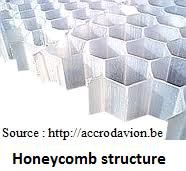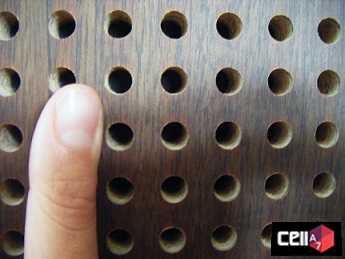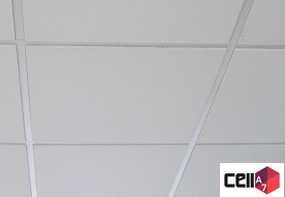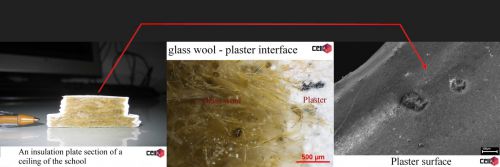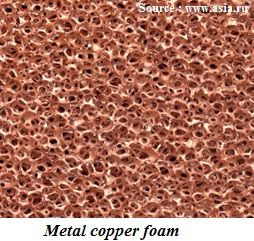What is a cellular material ?
Cellular materials
A cellular material is defined as a porous material which has an organized structural layout and a ratio matter/air rather low. This structural layout enables to support different kinds of stresses: mechanical, thermal while remaining light.
In natural state, there is this kind of structure in the wood, sponges or bones and teeth.
You can see more pictures if you click here.
Considering that interesting properties (lightness and solidity), Human being had created synthetic cellular materials to meet his needs.
There are two kinds of major structures: honeycomb structure and sponge structure.
Honeycomb structure has regular size and shape cells. It is used in order to reinforce resistance of a part and guarantee a maximal lightness (vacuum rate around 95%). It is especially used to absorb impacts because it has an aptitude to deform itself and to absorb mechanical waves. Honeycomb structure can be produced with aluminium, paper (cardboard) or plastic. We can find this structure in aeronautic industry where they fill empty volumes but also in automobile, yachting and wind-powered applications.
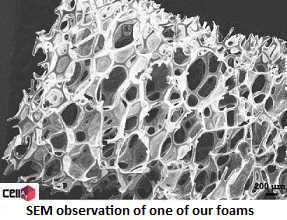
Sponge structure also called foam has opened cells which have different shapes and sizes. Vacuum rate is around 95 %. We find this structure in living beings’ bones and in wood where it enables connection between cells. These properties give an important versatility for its use. It is used in engineering field but also in mechanics, aeronautics, chemistry (porous catalyst) and medical (ceramic implant).
These materials were created industrially rather late. The first one was baking brick for its thermal properties in 3500 BC.
Cellular materials in ENSIACET
Our school is built with lot of cellular materials we can observe in many classrooms, lecture hall and also at the library.
To understand their utility, we looked in the school building files to know how the choice and the place of this materials had been decided.
You will find below a description of a few of them that you can easily see at school.
For exemple, the lecture theatre 300 is mainly constituted of plasterboard with holes of 1 and 2 centimeters diameter. We find this material both on the ceiling and on a part of the walls, as show the picture bellow.
Plaster is a very porous and soundproofing material. Having the lecture theatre made of plasterboard with holes provides the material a macro and a microscopic porosity that make it absorb a wide range of sound waves to reduce the overall noise in the room.
We find also wooden plates with more smaller holes of 1 centimeter diameter as you can see on the picture just above.
In class room, where you have less people, we find false ceilings which have also the ability to absorb sound. This ceiling is composed by removable glass wool plates covered with a thin plaster layer. Each plate is a square whith a 60 cm side and a thickness of 2 cm.
As this material is quite easy to get, we have studied it more accurently watching it with an optical microscope, a binocular microscope and the SEM.
As we can see on the picture, the glass wool is cellular material that occupies almost the entire plate. We deduce that ceiling plates has a thermal insulation function.
______________________________________________________________
Generally, these cellular materials are made for the classrooms acoustic insulation. Their shape and composition depend on the room size. Indeed, the more people there are inside, the more the material have to be soundproofing to make the speaker being heard.
These materials were choosen also for an esthetic point to give the school a modern aspect. Some of them iare made to be easily removed like the false ceiling plates which hide pipes that must be accessible for maintenance.
The use of cellular materials
The porous structure of these materials gives them a large number of properties and allows them to be used for many different applications.
In our project we focused on the acoustic characteristic of porous materials.
But, cellular materials have many others feature that make them useful for a lot of different sector of activity as construction, transportation and aeronautics.
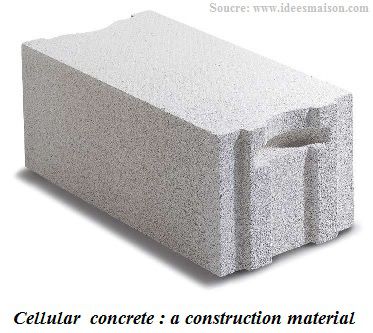
Many cellular materials are used in building trade.
For example, cellular concrete is a lightweight cement-based material, containing many gas bubbles evenly distributed in the volume. It is harder in comparison with traditional insulation materials, and have a good fire resistance. Due to the porous structure, it provides thermal comfort in the house by reducing heat losses in winter and cool losses in summer. This is also a good sound-proofing material.
The very low ratio material / air of cellular materials give them a very good ability to absorb shocks.
Cardboard, like many other cellular materials, is used in the packaging industry for handling operations. These materials rigidify the product’s wrapping and increase product’s protection during transportation.
The conseption of innovative aerospace materials must meet two basic criteria: increase mechanical performance and minimize the mass. This dual requirement led the cellular materials class. These materials have the specific physical properties that depend on both their constituent material and their spatial arrangement. Metal foams and honeycomb are examples of cellular materials for this kind of use.


